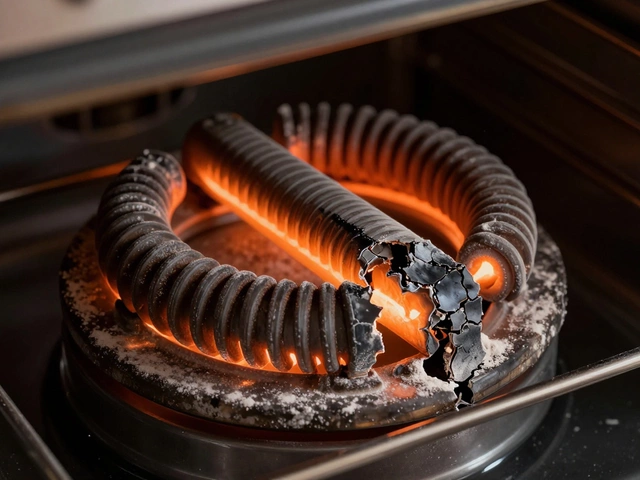Picture this: you’re ready to bake a homemade pizza, you set the temperature, and… nothing happens. No glow, no heat—just disappointment. A faulty oven element is a day-ruiner and a common headache, but it doesn’t have to break the bank or mystify you. The real kicker? Most people have no idea what impacts the price of electric oven element replacement, or how much they can actually expect to shell out in 2025.
Understanding Electric Oven Elements and Why They Fail
Every electric oven relies on special heating elements to do its job. You’ll usually find a big, looped wire at the bottom for baking, and another at the top for broiling. When you set a temperature, electricity flows through these elements, turning them red-hot and cooking your food. But even these workhorses have their limits. If you’ve noticed your food cooking unevenly, longer-than-usual preheating times, or a total lack of heat, your element could be the culprit.
Oven elements can fail for a bunch of reasons. Surges in electricity, worn insulation, or even a spilled lasagna that gets baked onto the coil can all shorten the element’s lifespan. Over time, constant expansion and contraction make the metal brittle. In the UK, the average life expectancy for an electric oven element hovers around five to eight years, but if you’re an enthusiastic home chef, all bets are off—it could go sooner.
Some folks don’t realize that oven elements are not universal. Each model can have a slightly different shape, wattage, size, and connector type. Try fitting a random coil into a modern Bosch or Smeg oven and you might get nowhere. That’s why it’s important to track down the exact model number of your oven before thinking about replacements. Manufacturers like Hotpoint, Beko, and Neff often use proprietary connectors, making generic swaps tricky.
Signs of failure usually show up before the element dies completely. Look for visible damage like blistering, holes, breaks in the coil, or scorch marks. If you’re hearing loud buzzing when the oven heats up, something’s wrong. Catching these problems early can save you from a total oven shutdown the next time you’re cooking for friends.
How Much Does It Cost to Replace an Electric Oven Element?
So, what’s the damage? As of July 2025, the average electric oven element replacement cost in the UK falls between £60 and £175, and this wide range depends on a mix of factors. Want to do it yourself? You could get away with spending £18 to £55 for a basic, no-frills element that fits many common models. Head online, search up your oven’s model number, and you might even score a next-day delivery from large suppliers like Currys or AO.com.
Labour makes up the other big chunk of the price. If you’re calling in a qualified appliance engineer, expect charges from £50 to £120 for the call-out and labour, depending on your location and how urgent the job is. London and the South East sit at the top of that scale, with smaller towns and the North coming in a bit cheaper. Evening or weekend repairs nearly always cost more—sometimes by 25 to 50%—so if you can, try to book during regular hours.
| Expense Type | Typical Cost (2025) | Notes |
|---|---|---|
| DIY Element | £18-£55 | Online or local parts retailer |
| Professional Element + Labour | £80-£175 | Includes callout and fitting |
| Element (Premium Brand) | £45-£95 | High-end brands (Neff, Smeg, AEG) |
| Diagnostic Visit | £45-£90 | Waived with repair in some cases |
A lot boils down to the oven brand and how easy the part is to source. For example, older models or luxury ovens might need a special order, which can bump up both price and waiting time. At the extreme, custom elements can run as high as £100-£140 just for the part. On the other hand, elements for brands like Hotpoint or Beko tend to be widely available, slashing costs and turnaround time.
Don’t forget about VAT, which some independent engineers add to the quote. It’s not a huge sum but it nudges the final bill higher, especially if you ask for an expedited appointment. Some warranties help—if your oven is under one, ring up the manufacturer before splashing out. While oven element replacement usually isn’t covered by basic home insurance, a few premium appliance insurance plans might pitch in.
Special note if your oven is integrated into a built-in kitchen cabinet or has a fancy double-oven feature: expect a 10-20% premium for the added hassle of dismantling and reassembling the setup during the repair. These jobs require a bit more patience and skill, so the higher price makes sense.

DIY vs Professional: Which Route Makes Sense?
The temptation to save money by swapping the oven element yourself is understandable. If you’re handy, have some tools, and aren’t put off by a bit of electrical work, a DIY fix is possible. Most manufacturers design elements to be replaceable by homeowners—typically, you’ll need a screwdriver and about 30-60 minutes. But don’t wing it! Always pull the oven out and unplug it (or turn off the fuse at the consumer unit) before starting, since you’re dealing with live electricity.
- Double-check your oven’s model number before buying a part. Matching it is crucial—just because an element looks the same doesn’t mean it is.
- Take a quick picture of wiring connections before removing the old element, so you don’t forget how to hook everything back up.
- Resist the urge to tug or bend the replacement element excessively. They’re delicate, and a kinked coil is a ruined coil.
- Don’t try to bend a straight element to match a curved space. If it’s not an exact fit, send it back.
There’s a fair bit of myth-busting around oven repairs. No, you don’t need special electrician certification to swap a simple plug-in oven element in most UK homes. But—if your oven is hardwired into the mains, or if you spot signs of melted wires, scorching around the connectors, or blown fuses, bring in an expert. Sometimes, what looks like a bad element is actually a failed thermostat or burnt wiring. Pros have the diagnostic tools and know-how to spot trouble fast.
What’s the worst that could happen with a botched repair? In the best-case scenario, the oven just doesn’t work. In the worst, you’re risking short-circuits, electric shock, or even fire damage. Factory-trained engineers also tend to guarantee their work for 12 months, so if the new part fails, you won’t be left in the lurch.
It’s also worth mentioning that landlords in 2025 face stricter regulations. If you rent out a property, you’re expected to keep ovens in safe, working order. Cutting corners on repairs could land you with fines or angry tenants, so most landlords choose to call a professional—especially if the oven is built-in or shared in an HMO.
How to Save Money—and Trouble—on Your Oven Element Replacement
Here’s the good news: even if your oven element bites the dust, this isn’t a bank-breaking repair. But a few smart moves can help you save cash and sidestep hassle:
- Compare prices: Don’t settle for the first quote. Ask two or three reputable appliance engineers for prices, and check if call-out fees are included. Watch out for extras, like disposal fees or expedited service.
- Use official channels for parts: Stick to trusted suppliers, and always check if you’re getting genuine parts. Knock-off elements might be cheap but often fail early, or worse, don’t fit at all.
- Bundle repairs: If another appliance (like your hob or extractor fan) also needs fixing soon, see if you can get a discount for multiple jobs at once. Many engineers appreciate the extra work and may trim the total bill.
- Look up your oven’s age: Elements wear out more frequently in ovens over seven years old. If your appliance is pushing a decade, weigh repair cost against a brand-new oven. Energy efficiency has improved, and you might save on running costs long-term.
- Regular cleaning helps: Spilled food and splatters cause hot spots and corrosion, ruining elements faster. A quick wipe of the oven (once cooled!) stops gunk from baking on the heating coils.
Busting a myth: don’t trust wild claims about “universal” elements. While some budget options promise a magical fit for every oven, success is hit-or-miss—especially if you own anything fancy or imported. Even high-rated online sellers warn to double-check measurements and connections before ordering.
If your oven element keeps failing every year or two, there could be a bigger problem. Electrical surges, faulty thermostats, or even a dodgy wall outlet can fry new elements in months. If this sounds familiar, it’s time for a full electrical inspection. Spending a bit now could save you a ton on fried appliances, not to mention peace of mind.
Swapping an oven element is rarely glamorous, but it’s about as straightforward as appliance repair gets. Most people are surprised at how quickly the kitchen’s back to normal. Armed with the right info, you won’t overpay or waste time—and you definitely won’t have to cancel pizza night.




